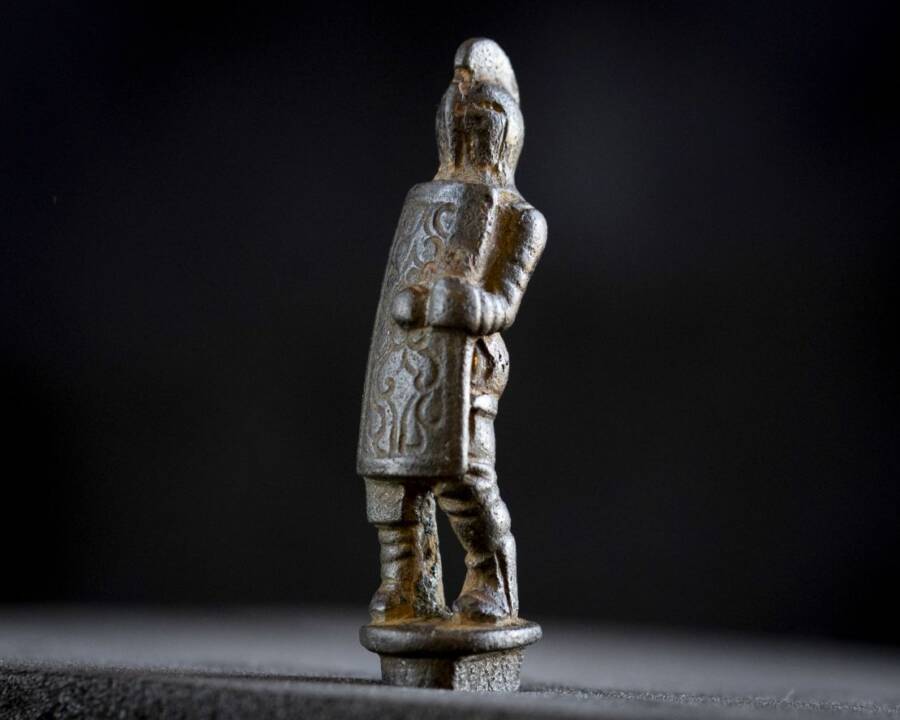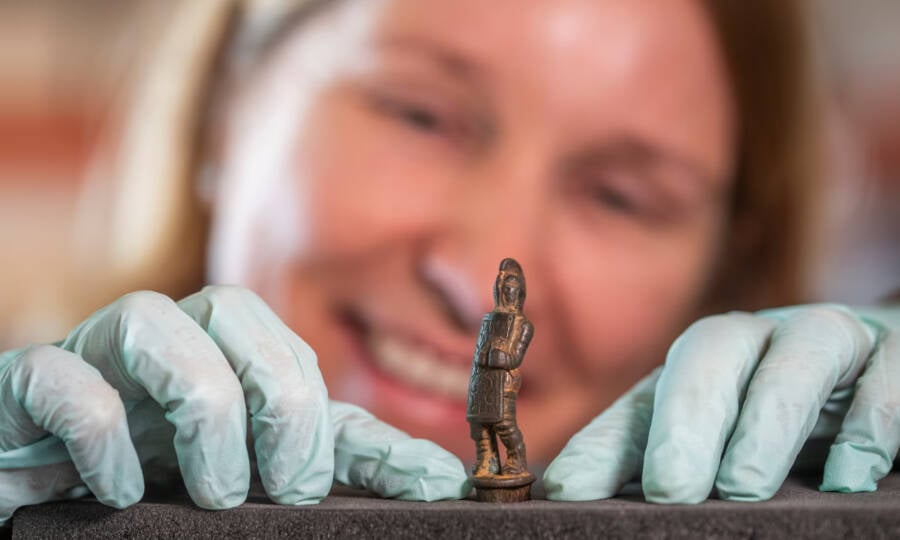Archaeologists excavating in northern England discovered a rare knife handle depicting a gladiator, revealing the reach of Roman celebrity culture across the empire.

English HeritageThe rare knife handle depicting a Roman gladiator that was recently found in Northumberland, England.
Archaeologists at Corbridge Roman Town, located near Hadrian’s Wall in Northumberland, England, have unearthed a rare knife handle depicting a Roman gladiator.
The figure, representing a heavily armored type of fighter that was trained for close combat, is remarkably well-preserved and offers a glimpse into the influence of Roman celebrity culture even at the empire’s fringes.
Gladiators in ancient Rome were indeed thought of as celebrities, especially if they were regularly victorious in their battles and animal hunts. Despite coming from low social status (many were prisoners or enslaved), their fame and influence extended across the Roman Empire, inspiring artifacts like the recently discovered knife handle.
This relic stands as a testament to ancient Romans’ fascination with gladiators — a fascination that persists for countless people around the world to this day.
Archaeologists Find A Roman Knife With A Gladiator-Shaped Handle Near Hadrian’s Wall

English HeritageThe ruins of Corbridge Roman Town, where the knife was discovered.
Recently, archaeologists excavating at the ruins of Corbridge Roman Town discovered the 2,000-year-old knife handle, which they pulled out of the River Tyne, and were immediately struck by its depiction of a gladiator.
A Roman settlement originally named Corstopitum, Corbridge was located along Hadrian’s Wall in Northumberland and was occupied from 79 C.E. to 400 C.E.
The knife handle, made from copper alloy, depicts a Roman gladiator wearing a helmet and equipped with a shield.
“It is amazing, it’s absolutely pristine,” said Dr. Frances McIntosh, English Heritage’s collections curator for Hadrian’s Wall, according to The Guardian. “To find such a well-preserved and interesting piece is remarkable.”
This figure represents a secutor gladiator, a type of Roman fighter that was heavily armored, specialized in close-quarters combat, and was trained to fight quicker, more agile gladiators of the retiarius variety.
Surprisingly, the figure was left-handed — a rare occurrence among Roman gladiators. Typically, left-handedness was seen as unlucky. However, some gladiators were trained to fight left-handed to give them an advantage in combat.

English HeritageDr. Frances McIntosh, English Heritage’s collections curator for Hadrian’s Wall, holding the knife handle.
With left-handedness being a rarity, it is likely that this figure depicts a specific gladiator rather than a symbolic representation of a fighter.
Gladiators: Celebrities Of Ancient Rome
The first recorded gladiator fight took place in 264 B.C.E. In the early 70s C.E., the Roman Colosseum was built to host gladiator fights and other events, like animal hunts.
These fights eventually increased in popularity, and gladiators became celebrities in Roman society. It’s likely that the gladiator depicted on the knife handle found at Hadrian’s Wall was one of these so-called celebrity gladiators.
“It could be that it is a very specific gladiator because gladiators were celebrity culture in the Roman world,” Dr. McIntosh explained. “Gladiators were big and individual gladiators, if they won multiple bouts, then they become better known.”
Despite their celebrity status, gladiators were often seen as low-class. Many of them were criminals or enslaved, and their reputations outside of the world of sport were less than stellar. That didn’t prevent them from receiving a certain measure of adulation, however.

English HeritageDr. Frances McIntosh shows off the Roman gladiator knife handle.
“There are lots of rumors that you see of high society women falling in love with gladiators,” Dr. McIntosh said. “Often a slur on somebody was that they had been fathered by a gladiator, that they were the son of a gladiator because their mother was…you know.”
However, as the knife handle proves, gladiators held a special place in Roman society, so much so that memorabilia was made using their likeness. Even to this day, countless people around the world remain fascinated by these ancient warriors.
“Even now, almost two thousand years later, the fascination around gladiators persists and has expanded even further into modern popular culture, as evidenced by the excitement surrounding the new Gladiator film sequel,” McIntosh added.
For those interested in seeing this piece of gladiator history, English Heritage plans to put the knife handle on display at Corbridge Roman Town as early as 2025.
After reading about the knife, dive into the story of Commodus, the most disastrous Roman emperor in history. Then, read the full history of why the Roman Empire collapsed.





